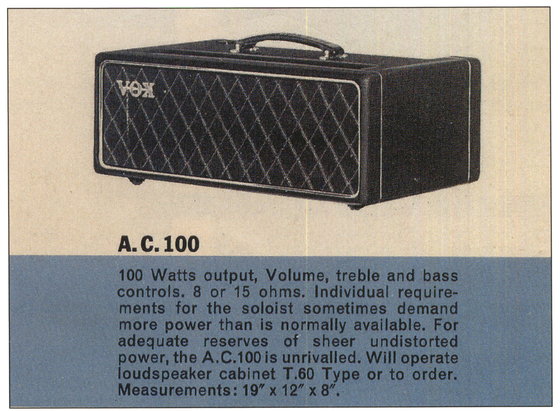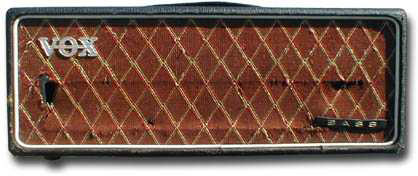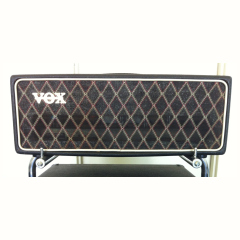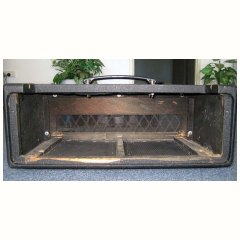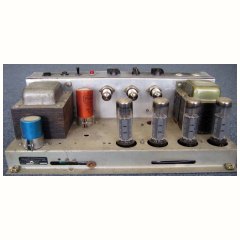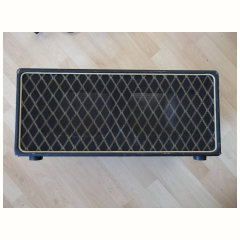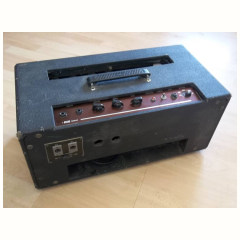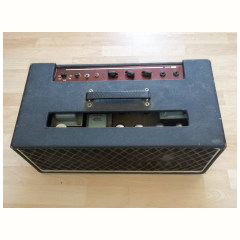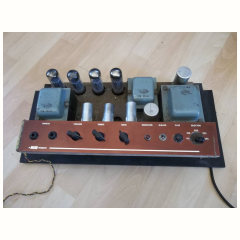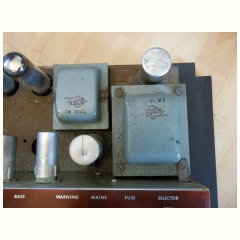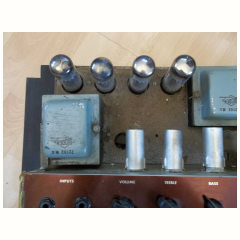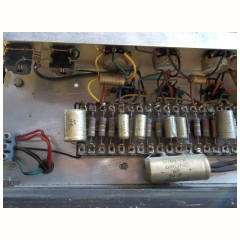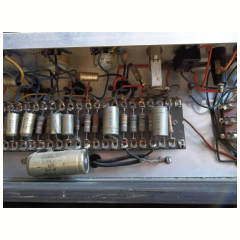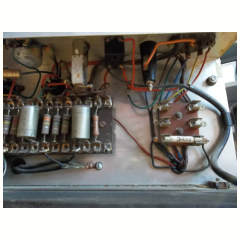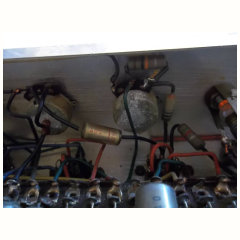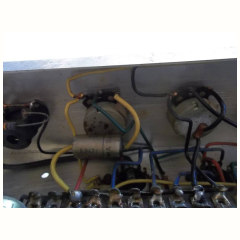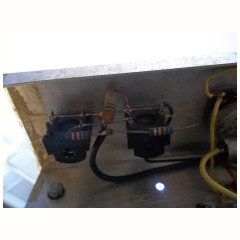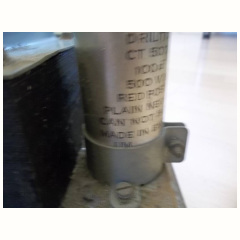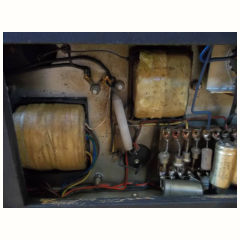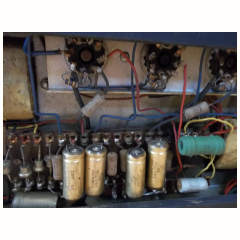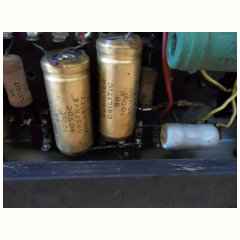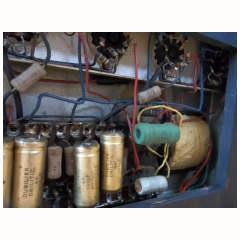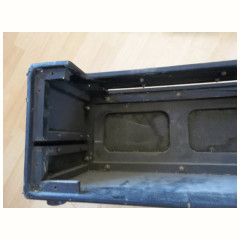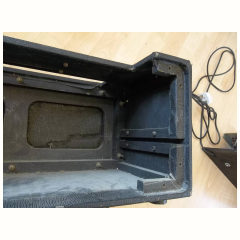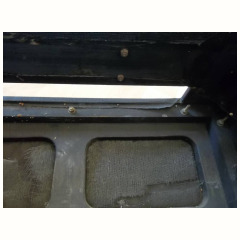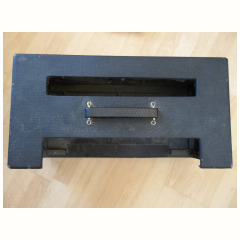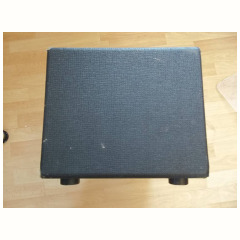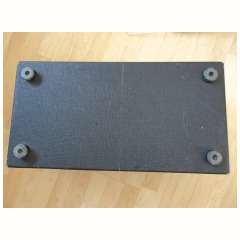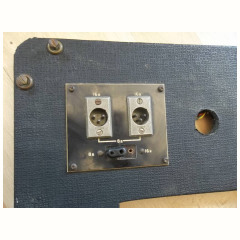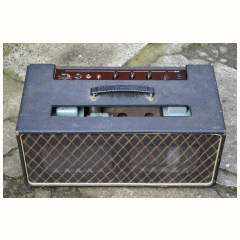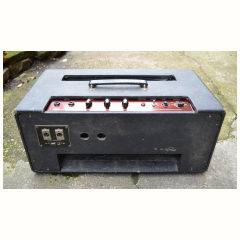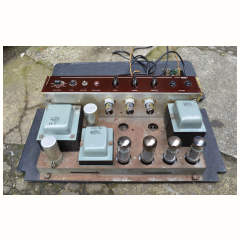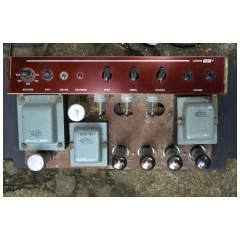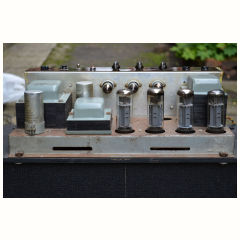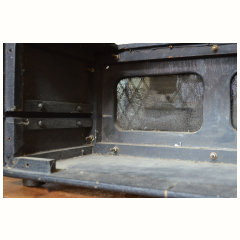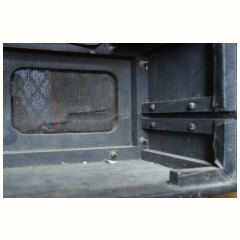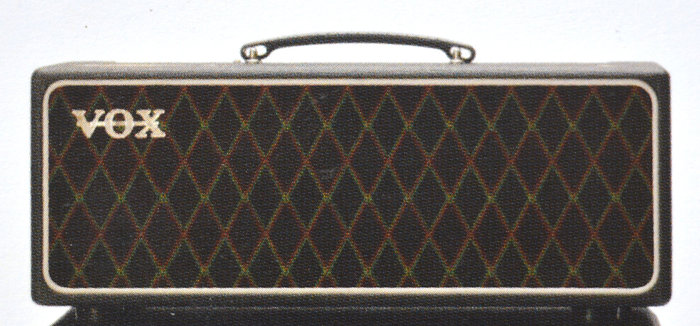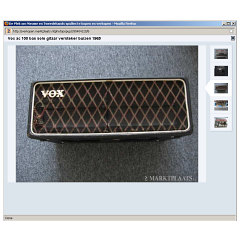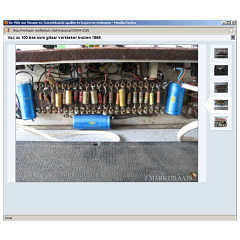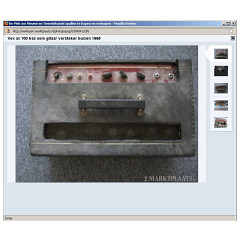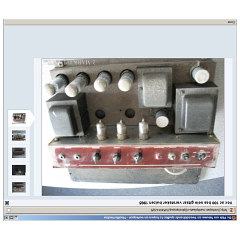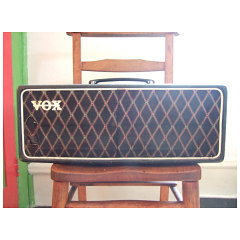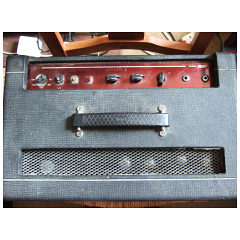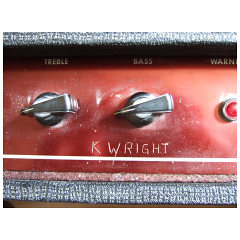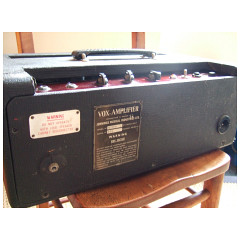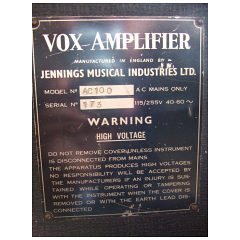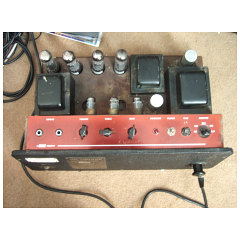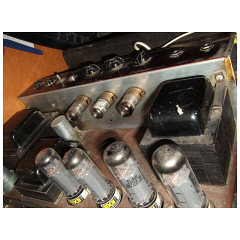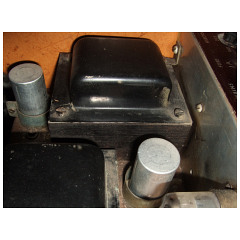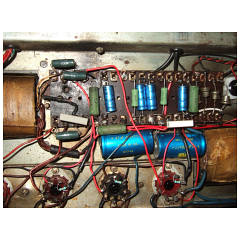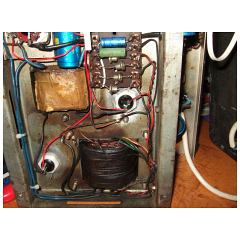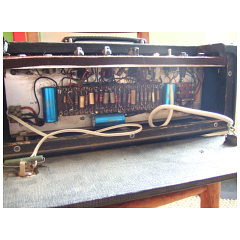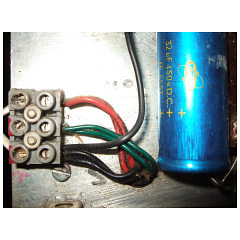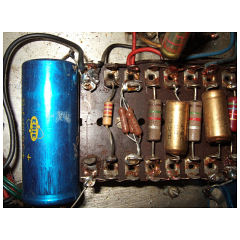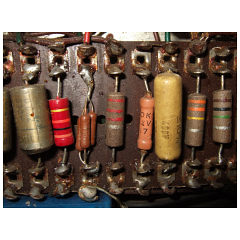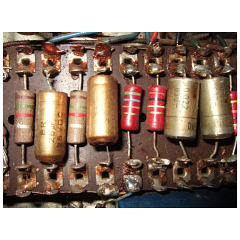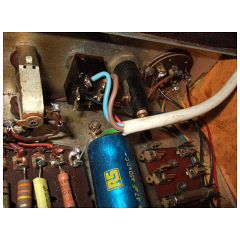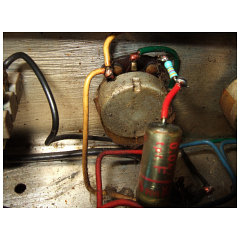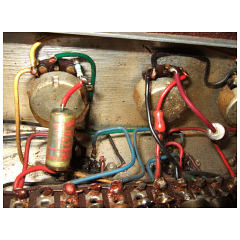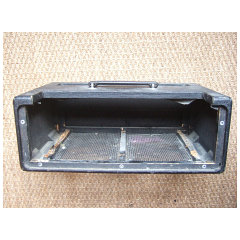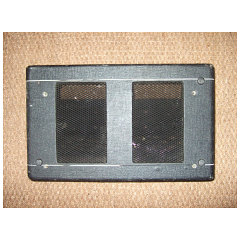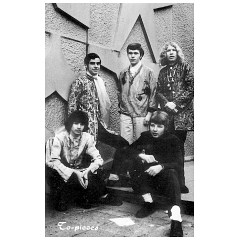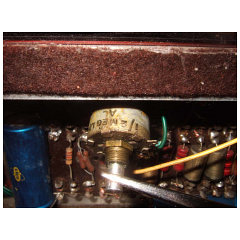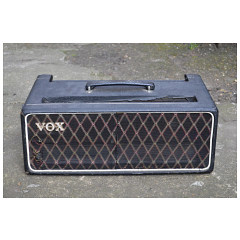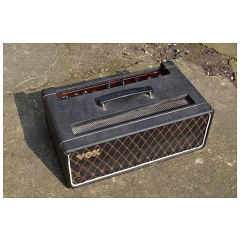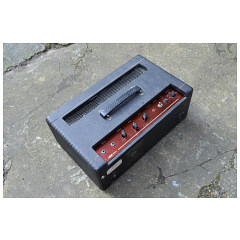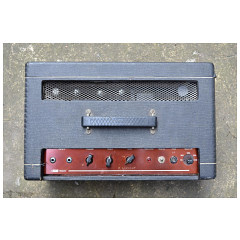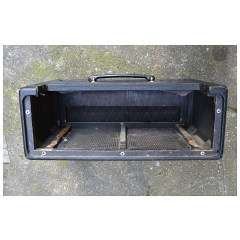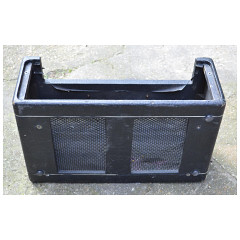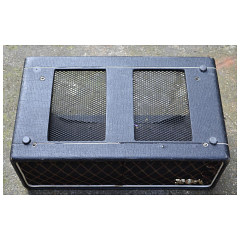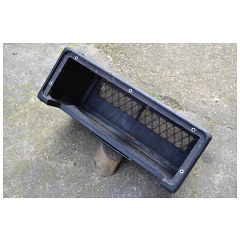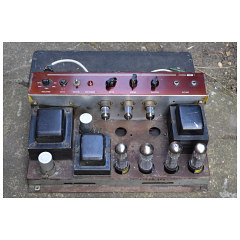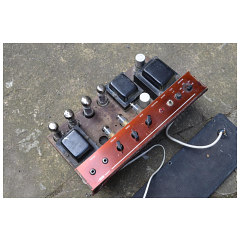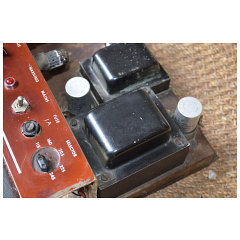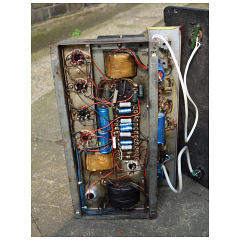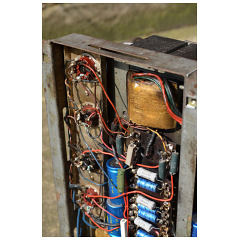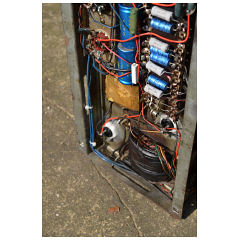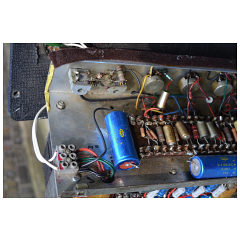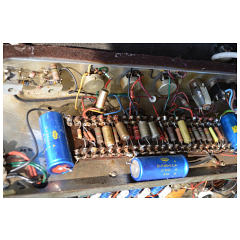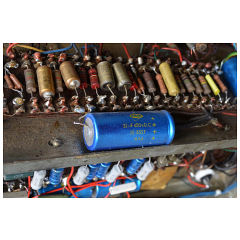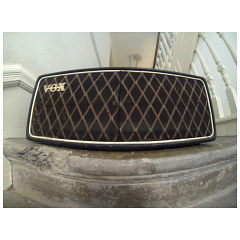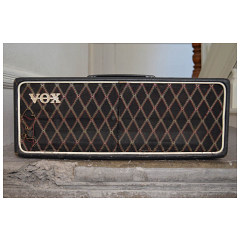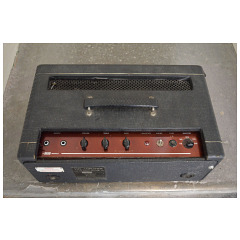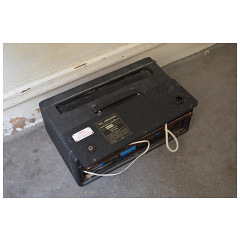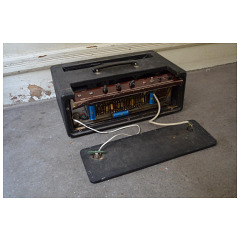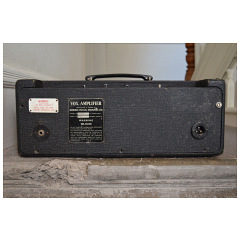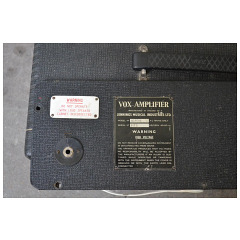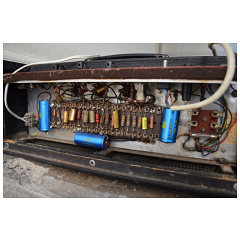Cathode-biased AC80/100s - thin edged boxes
Late 1963 - Autumn 1964
Serial nos 150 - 173
Above, the AC100 amplifier in a Vox brochure, February 1964. Note the evisaged use for bass: "Will operate loudspeaker cabinet Type T60 or to order." It was not until August that the guitar speaker cabinet so familiar from Beatles concerts was introduced.
The first "public" advert for the AC100 appeared in "Beat Monthly" magazine, a publication aimed squarely at the professional musician, no. 12, April 1964. The full-page ad can be seen on this page.
The first two hundred or so AC100s - more correctly AC80/100s, as the cathode-biased circuit gave closer to 80W than 100W - were produced in thin-edged boxes. Later boxes had thicker sides. For an overiew, see the general introduction.
Above, a detail from a shot of Gene Vincent and the Londoners on stage at the Empire Pool, Wembley, 20th November 1964. The full shot is available here. Note the presence on the new Super De Luxe speaker cabinet of a thick-edged AC80/100 (with no corner protectors). An earlier thin-edged amp sits on the drum riser.
This picture therefore suggests that all thin-edged amps - on this page and the next - were made before November '64. The chassis were built under contract for Vox by Westrex, based in North London, and sent to Dartford Road for boxing up. Part of the process of boxing up involved, of course, connecting up the back panel, which is likely to have been made ready with a serial number plate, warning plaque, and the relevant sockets for mains and speaker.
The presumption has been for some time that serial numbers began at 100 or 101. However, Paul McCartney's amp, the first to be issued, is serial no. 150B. Lower numbers have been claimed for other amps, but no reliable evidence has so far been presented.
The schematic for the circuit is available here. All so-called "AC100s" were built to this overall design until the summer of 1965.
Early amps have copper control panels, link voltage selectors, and green coloured Woden transformers. A small number, however, were produced with black cloth.
The amps listed below are necessarily not a complete record of survivals. If anyone knows of any others, please email me at click here for the address. This page will be updated, so please come back to look from time to time.
Questionable serial numbers
Serial number 117 (?)
A large question mark hangs over this one - asserted to exist in the early 2000s, but never demonstrated.
Serial number 119 (?)
Cited by Jim Elyea, Vox Amplifiers, p. 452 as having serial number 11 19. Doubtless an AC80/100 with a copper panel and hand-stamped plate - otherwise it's simply 1119. This is either a nonsense number, 119 (unlikely), or 219.
Attested serial numbers (or none)
Serial number 150B - Paul McCartney's first AC80/100
A detail of Paul's amp on stage, Versailles, 14th January 1964. The AC80/100 had been issued to him in late December 1963.
Rehearsals for the Christmas Show, Hammersmith Odeon, December 1964. Picture courtesy The Beatles Book Photo Archive.
A general detail from the picture above, Paul's first AC80/100 being used by George.
A detail, inverted and slightly enlarged, from the high resolution file - 150 B on the plate.
Paul's amp was the first AC80/100 made. No other amp has come to light with a fuseholder on the back panel, sideways Cannon power socket, or with white jack plug sockets. Note that the serial number plate is of the early type, and that the designation "B" is also found on the plates of early single channel, two input AC50s that were paired with Foundation Bass cabs. See this page on the AC50 website.
Serial number 150 - currently in Florida
This amp was issued to Bill Wyman in February / early April 1964 and used by him into early 1965. It was then returned to JMI, refurbished, and sold in the USA.
Above, serial number 150, bought second-hand from Cecil Gullickson's Music Mart., Orlando, in 1966. It was sent out to Florida from JMI refurbished.
The back panel, photographed in 1999. Note that the serial number plate has short silver panels and only 8 lines of text.
The Mad Mod Ball, Empire Pool, Wembley, 4th April 1964. The back of Bill's first AC80/100 - two latching Cannon XLR-3-13 speaker sockets one above the other, and a Bulgin mains socket - is just visible through the railing at right. Is there an unused screw hole on the top edge of the back panel above the uppermost speaker socket?
The Mad Mod Ball - the stage, showing the early AC50 (and cover) as spare.
Above, a detail from a pic. taken in July 1964, again showing the back panel of Bill's amp. The arrow indicates the reflective black of the Bulgin mains socket and connector.
Above, a schema of the back panel of 150 and Bill's amp. Whether 150 and Bill's amp are one and the same remains to be seen. Panels were fitted out at Dartford Road and tend to be similar for batches of amp - see for instance numbers 177 and 178.
A composite showing the match between the grille cloth pattern of no. 150 and Bill Wyman's amp, photographed on stage, NME Poll Winner's Concert, 28th February, 1965.
As the Beatles Gear section on the now defunct VoxTalks website indicated in the early 2000s (see the screen-shots above), the amp was purchased in October 1966 by Dave Morris, bassist of the Rocking Roadrunners, from Cecil Gullickson's Music Mart in Orlando, Florida, having been refurbished by JMI and sent over to the States for resale. For years, no. 150 was pictured on the voxamps.com website (but is now no longer there), though it never belonged to Korg or Vox. The claimed association of the amp with Paul McCartney is unfortunately erroneous.
Note the arrangement of its back panel - a completely different arrangement from the panels of the amps that McCartney is pictured with - but it does match perfectly that of the amp that Bill Wyman had in early April 1964. For more on the Stones, see this page. Serial no. 150 is reported in Jim's book, p. 448, and was featured in an excellent short article by Mitch Colby, 20th Century Guitar Magazine, July 1999, p. 113 - click here for a PDF.
The remaining original speaker XLR is a latching Cannon XLR-3-13. Paul McCartney's amp - see the entry further up this page - had a similar connector. The barrels are 1 inch in diameter (rather than the 3/4 inch of the rectangular Cannon XLRs.)
Note that the serial plate has 8 lines of text. Later AC80/100s have 9 lines. "50" is chalked inside the box. Thanks to Dave Morris for the info.
During the course of production, the serial number plate changed from 8-line to 9-line.
Serial number 162 - currently in Japan
Pictures from "The Beatles Equipment Stories" published in Japan in 2010 (Shinko Music Entertainment Company Ltd) - AC100 serial number 162, copper panel, brown cloth, BASS flag in place. To judge from the details, the back panel has its original Cannon XLR-3-32 and Cannon LNE-32 sockets.
Thin-edged box (containing a later amp)
Thin-edged box with original black grille cloth. Note however, that there is no "scrim" behind the grille cloth, no aluminium blind rivet nuts for the back panel screws, nor any internal bracing for the sides - see the images of the box of no. 173 below for comparison. Perhaps refurbished - the baffle is not blacked. This box has been the home for at least 15 years of an AC100 produced by Triumph (and bearing a Triumph plaque) in 1967 - the amp is illustrated on the Triumph-made amps page. Its closest relative, it should be said, also lives in an unexpected box. The back panel has a Cannon mains connector, and now two round Switchcraft XLRs, replacing the original rectangular Cannons. No serial plate on the back, nor any warning plaque.
Serial number unknown - currently in the UK
In excellent electronic condition. One of the most original chassis of those pictured on this page. The plate resistors and part of the underside power board flamed out at some point, a fate that seems to have befallen almost all early AC80/100s, but otherwise very very few replaced components. Note the 1M white Erie resistors in the preamp. Visible capacitor codes - UK - date to October 1963. Capacitors bearing these codes run through to amps with serial numbers in the 300s. Westrex, the contractor that made these chassis, evidently had substantial stocks. The same is true for the 270ohm cathode resistors, which have codes VA = January 1964 - one finds these also in serial number 185. The thin-edged box is intriguing - professionally made, but in the format of an "expanded" large AC50 box. Large AC50 boxes have front grilles that are 4 diamonds tall and 15 wide. This box is 4 1/2 diamonds tall and 17 wide. Note the careful cut-outs of the baffle, and the scrim behind the grille cloth. Was this perhaps a special order or a prototype of some sort? It must be said, however, that the cloth more resembles that used on solid state amps in the later 1960s.
The panel with the XLR speaker connectors is from an early large-box AC50
Serial number 169 - currently in the USA
Illustrated in Jim Elyea's book. Nine-line serial number plate. Its black grille cloth, which is unlikely to be original. In one picture in the book, the amp is shown sitting on an original Mk1 trolley (which in actual fact belongs to serial no. 225, not this amp), with a square "basket" to hold the amp securely. It seems unlikely, however, that s.n. 169 was produced to accompany a speaker cabinet and trolley of this type.
Serial number 173 - currently in the UK
Bought second hand from Macari's on Charing Cross Road in 1969 by the manager of the Dutch band, the "To-Pieces" (pictured above). The first five pictures above show the amp shortly before its arrival in the UK - it had been in the manager's loft. Used by the bassist of the group, Joop van der Brugge, standing centre. The amp had already had at least one owner by 1969, however - K. Wright, who inscribed his name on the control plate. The grille cloth has probably been replaced (with two pieces forming a seam in the middle), and at some point the plate resistors went up in flames and were renewed, along with a few other components. The power section tagboards of AC80/100s seem regularly to have burned out. The transformers are the original green Wodens, painted black doubtless in an attempt to retard heat.
The date code on the volume pot is AL = January 1964, which is also the date of the volume pot of the amp second from bottom on this page. Westrex clearly had enough stock to last through to late 1964. New picture added above (26 June 2012).
